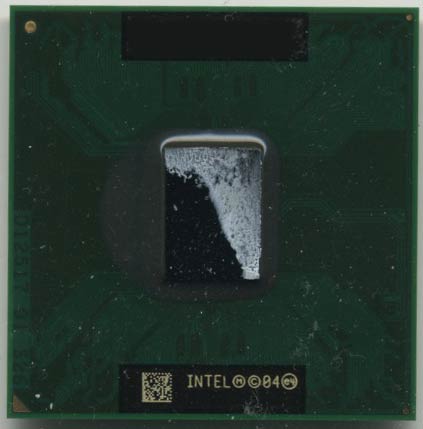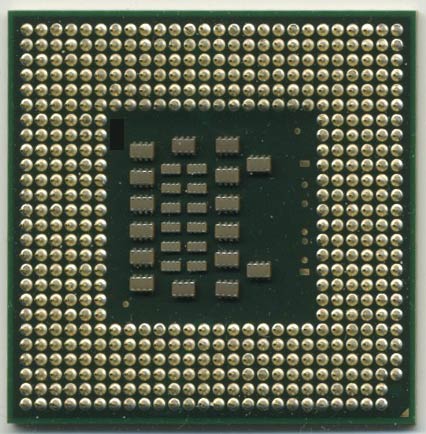Intel Yonah Performance Preview - Part I: The Exclusive First Look at Yonah
by Anand Lal Shimpi on November 30, 2005 2:50 AM EST- Posted in
- CPUs
Intel, oh Intel, how uninteresting your processors have been to us for so long now. Where have the days of the Northwood gone? Prescott brought us a minor bump in clock speed, minor increases in performance, and more importantly - major increases in power bills. But if any company can go down the wrong path for five years and still come out on top, it’s Intel. So starting next year, we’ll start seeing a new Intel. A more power conscious Intel and to kick it all off will be Intel’s first Earth-friendly dual core processor: Yonah.
As the successor to the current Pentium M (Dothan) and the predecessor to next year’s Conroe, Merom and Woodcrest cores, Yonah is a very important chip. As a mobile processor Yonah will bring dual core to thin and light notebooks, basically anywhere you’d find a Pentium M, you’ll now be able to find two Pentium Ms. The implications for mobile performance are huge, as multitasking on notebooks has rarely been all that great of an experience. At the same time, Yonah is so much more than just a dual core mobile processor - it’s a predictor of the performance of Intel’s next-generation desktop micro-architecture. Sure, it won’t have all of the architectural bells and whistles that we’ll see when Conroe debuts at the end of next year, but it’ll have many and that makes it a reference point.
The problem with the Pentium M architecture has been that although it’s traditionally done well at office tasks and obviously in the power consumption department, it has lagged behind the Pentium 4 and Athlon 64 when it comes to FP intensive applications such as video encoding, and to a lesser degree, 3D gaming. With Yonah, Intel has promised to address those performance issues, and even more so with their next-generation micro-architecture later next year. But we tend to want to see things for ourselves, and Yonah will at least give us an indication of how things have improved since Dothan, and whether or not Intel is on the right track to replacing the Pentium 4.
By now we’ve hopefully stressed the importance of Yonah, and there’s just one more detail to mention - we have one.
The Platform - Yet Another Socket
While the launch of Yonah still won’t be until January of next year, we’ve had a chip for the past month, unfortunately, we haven’t had a motherboard to stick it in. We finally got one two days ago, which is why you’re seeing this article now, instead of more pictures of our Yonah posing alongside the Xbox 360. The problem is that Intel seems to have changed sockets once more, meaning that Yonah is not backwards compatible with the original Pentium M socket.

If you’ll remember back to the introduction of the Pentium M, Intel introduced a brand new socket for the processor: Socket-479. Back then, the desktop Pentium 4 still used the pin-based Socket-478, so the different pin-out was a bit of a pain to deal with as we all wanted to be able to stick Pentium Ms in our Pentium 4 motherboards.

The Yonah socket is still a 479-pin interface, however the pin-out has been changed once more, and of course Yonah won’t even physically fit into any current Pentium M motherboards. Instead, you’ll need a brand new motherboard with a brand new chipset. So if you invested in any of the handful of desktop Pentium M motherboards that were released over the past year, you’re unfortunately out of luck.

Yonah (left) vs. Dothan (right) - Note the different pin-out
What’s this about a new chipset? Well, it’s not exactly a new chipset, rather it’s Intel’s mobile 945 chipset - the mobile version of the desktop chipset we’ve had for quite some time now. The platform we’re testing on in particular uses Intel’s 945G chipset, with integrated graphics, but of course we aren’t too interested in integrated graphics performance so we’ll be using the PCIe x16 slot on the board.
While we can’t tell you who makes the motherboard we’re testing with, the important thing to note is that it is a desktop motherboard made specifically for Yonah. It’s got a single PCIe x16 slot, meaning you don’t have to rely on integrated graphics, and all of the bells and whistles you’d expect from a desktop motherboard; this could very well be the heart of your next system.
We’ve been hearing that Pentium M based desktops will become a lot more common next year, and this motherboard is definitely an indication of that.










135 Comments
View All Comments
Furen - Wednesday, November 30, 2005 - link
It's not supposed to compete against the 3800+ (But it would have been nice if it could match X2s clock-for-clock, at least, since X2s will hit 2.6GHz soon enough) and it does very considering its power consumption.I must say that it looks like 90nm dual-core Turions will be a very good match for these though (which I still dont think they'll hit 35W max power draw), since Yonah on a mobile chipset only uses 25% less power than a "high-voltage" X2 on a desktop chipset.
fitten - Wednesday, November 30, 2005 - link
18% less power at idle and 33% less power under load supposedly with the same video card, HDD, and all of that (they didn't actually reiterate the test system configurations, just said they were the same and were the same as configured in a different article).Remember... the board tested with Yonah was a desktop version board, not a laptop configuration AND both the Yonah and the board it was on were pre-production test boards. It used the 945G chipset but that doesn't mean that the board was designed in any way like a laptop board. Of course, all of the numbers (performance and power) are subject to change (can be up or down) when Yonah and boards are in production.
I wish the Yonah would have been faster, too. It does well in some areas (nearly equaling the X2 4200 which is 200MHz faster clocked) but others it seems to fall down. It looks like the FPUs weren't beefed up enough and it still isn't up to par main memory wise as the Athlon64s.
Carfax - Wednesday, November 30, 2005 - link
Please post some overclocked scores!bigtoe36 - Wednesday, November 30, 2005 - link
AnandPlease lower the multiplier, run 200fsb with the ddr2 in 1:1 mode and give us a true apples to apples comparison against X2.
EIST should work with clockgen in windows if the bios is poor on your board.
Thanks
Beenthere - Wednesday, November 30, 2005 - link
As other PC industry folks have already stated, Yonah, aka YAWNER, is too little, too late and not worth even bothering with. When Conroe and friends arrive, AMD will have already released faster, cheaper X2 CPUs so Intel is still 2 years behind and loosing ground. Why would anyone buy an obsolete, under-performing CPU that requires a new Mobo? Makes no sense.Calin - Friday, December 2, 2005 - link
No, they are fine. They are as fast as the X2 3800+ processors in almost everything (except heavy non-SSE floating point), and they consume less. Everything depends on the price Intel will ask for them.And I would certainly prefer that Yonah over a Pentium D 830. Why there was no power comparison to the D 830 line too?
DrZoidberg - Wednesday, November 30, 2005 - link
Yonah looks ok for notebooks. I mean its slower than AMD X2 but as a mobile processor, its real competitors are AMD Turion and Sempron and Pentium Centrino not X2.I do hope Intel wont price gorge dual core notebook processors, hopefully they only be slightly more expensive than Dothan.
Viditor - Wednesday, November 30, 2005 - link
Actually, it's real competitor is the dual core Turion...I suspect we shall see AMD extend their lead into the mobile sector this next year.
I must say that I had one dissapointment with this preview...
While Anand finished with power numbers, he didn't tell us how or what they measured. For example, was it the whole system or just the CPU? Did it include the Northbridge numbers for Yonah (since these are alreeady included in the X2)? How does this compare to the numbers from the Turion?
tayhimself - Wednesday, November 30, 2005 - link
Well you suspect wrong, which I suspect, in your case, is quite often. First, there are no dual core Turions on the horizon. Second, AMD is not having much success in that sector because intel's platform strategy is useful for laptop builders. Third, Turion power consumption isnt quite on the same level as Dothan. They will need to move to 65nm before building Turion laptops.
Viditor - Wednesday, November 30, 2005 - link
Sigh...have you ever heard of Google before? It's a wonderful little search engine that would have shown you inumerable articles on the Dual Core Turion being released in early 2006...
Gee...then increasing their marketshare by 75% from Q2 to Q3 was unsuccessful, eh?
If someone could translate this for me, I'd be happy to respond...